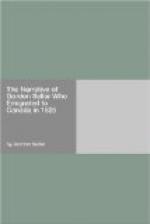My desire is, to see Canada a land where every man who wishes may own a part of God’s footstool and, by industry, secure a decent living. Surely it is a patriotic duty to make Canada a nation where toil and thrift fetch the reward of independence, a nation without beggars or of men willing to work and cannot get it, a nation of happy homes where there is neither wealth nor luxury but enough of the world’s means to ensure comfort and to develop in its men and women what is best in human nature.
CHAPTER X.
PARTING WITH OLD FRIENDS
My story of how I came to Canada and how the family which made me one of their number got on in its backwoods has taken a long time to tell, yet I must lengthen it to make known what became of some of the people mentioned in the course of it. Tilly remained with us a year, when she went to live with the Bambrays, who needed her help. When they, later on, decided to end their days in their native town, Huddersfield, she went with them to England. Once a year a letter came from Mr Bambray, with a long postscript by Tilly, overflowing with good wishes, and in each letter was a draft to help escaped slaves get a fresh start in life. The worthy couple died several years ago, making Tilly their chief legatee. She married a man for whom she described herself as unworthy and who makes her happy every day. When Ruth married she sent her a gift of $250 to furnish her house. Ruth’s husband is a capable farmer, who is doing well. They are an evenly matched team, pulling together and happy in each other. When Robbie came of age the master divided his farm equally between his two sons, and bought for himself six acres fronting Yonge-street. On this he built a commodious house and a large greenhouse, for he designed carrying on market-gardening. In an excavation deep enough to be below the frost line the greenhouse was built, and there were other devices to do with as little stove-heat as possible. Sloot, who had been left a widower, and having no family, became the hired man and made his home for the remainder of his life with the master and mistress, to whom he was deeply attached. Twice a week he drove to market the produce that was for sale, and though occupation not beyond their strength was their purpose, remarkable profits were made off these six acres. The mistress was happy in tending the greenhouse and flower-beds, and in entertaining visitors, for they had many apart from their own children and grand-children. They were honored far and wide and a drive to their house, which they named Heatherbell cottage, to have a chat and get a bouquet was a common recreation with many Torontonians. Of your mother I need not speak; you know how happy we are in each other. We never had any courtship—our lives from the first sight of her when I ventured to seek shelter in her father’s house on that rainy day has been one long dwelling in each other’s affections.




